The Perfect Baked Salmon Recipe for Cozy Weeknight Dinners
Crafting a delectable baked salmon recipe brings pure joy to home cooking enthusiasts.
Seafood lovers appreciate salmon rich, buttery texture and incredible nutritional profile.
Mediterranean-inspired seasonings can turn this dish into a culinary masterpiece.
Fresh ingredients make all the difference when preparing this elegant meal.
Wild-caught salmon provides superior flavor and omega-3 benefits that nourish your body.
Simple techniques will help you achieve perfectly flaky, moist fish every single time.
Let this recipe inspire you to create a restaurant-quality dinner that impresses and delights.
Baked Salmon Done To Perfection
Essential Ingredients For Baked Salmon
Main Protein:Glaze Ingredients:Seasoning Ingredients:Garnish:Easy Steps To Bake Perfect Salmon
Step 1: Prepare Oven and Baking Surface
Crank up your oven to 400°F. Grab a baking sheet and line it with parchment paper or aluminum foil to make cleanup a breeze.
This simple trick saves you scrubbing time later.
Step 2: Position Salmon Fillets
Arrange salmon fillets skin-side down on the prepared baking sheet.
Ensure they’re not overcrowded, allowing each piece to cook evenly and develop a delicious golden crust.
Step 3: Create Delectable Glaze
Whisk together a mouthwatering glaze with:Blend these ingredients until they form a smooth, glossy mixture that will make your salmon irresistible.
Step 4: Coat Salmon with Glaze
Using a pastry brush, generously spread the glaze over each salmon fillet. Make sure every inch is covered for maximum flavor and a gorgeous golden sheen.
Step 5: Bake to Perfection
Slide the baking sheet into the preheated oven. Roast for 12-15 minutes until the salmon flakes easily with a fork and reaches an internal temperature of 145°F.
Step 6: Optional Caramelization
For an extra flavor boost, switch your oven to broil. Caramelize the salmon for 2-3 minutes, watching carefully to prevent burning.
Step 7: Garnish and Serve
Pull the salmon from the oven and sprinkle with freshly chopped parsley. Serve immediately with lemon wedges for a bright, zesty touch.
Bon appétit!
Tips To Nail Baked Salmon Every Time
Variations To Refresh Your Baked Salmon
Pairing Suggestions To Enjoy With Baked Salmon
Storage Advice To Keep Baked Salmon Fresh
FAQs
Use a fork to check if the salmon flakes easily and use a meat thermometer to ensure the internal temperature reaches 145F (63C). The fish should look opaque and have a slightly firm texture.
Yes, thaw the salmon completely in the refrigerator before cooking. Pat the fish dry with paper towels to remove excess moisture, which helps achieve a better glaze and prevents steaming.
You can substitute with whole grain mustard or yellow mustard. If you don’t have mustard, increase the garlic and add a bit more lemon juice to maintain the flavor profile.
Print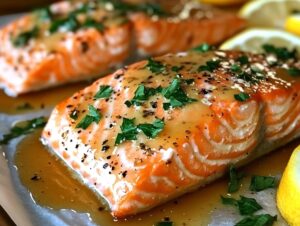
Baked Salmon Recipe
- Total Time: 28 minutes
- Yield: 4 1x
Description
Succulent Baked Salmon brings Mediterranean coastal flavors directly to kitchen tables with its herb-infused elegance. Crisp herbal notes and delicate fish textures create a simple yet sophisticated meal perfect for weeknight dinners or special gatherings.
Ingredients
Main Proteins:
- 4 salmon fillets (6 ounces/170 grams each)
Seasoning and Flavor Enhancers:
- 3 tablespoons melted butter
- 3 cloves garlic, minced
- 1 tablespoon Dijon mustard
- 1 teaspoon paprika
- 1/2 teaspoon salt
- 1/2 teaspoon black pepper
- 1 teaspoon fresh parsley, chopped
Sweet and Tangy Ingredients:
- 2 tablespoons honey
- 2 tablespoons fresh lemon juice
- Optional: Lemon slices for serving
Instructions
- Prepare a baking sheet by lining with parchment paper or aluminum foil, then preheat the oven to a precise 400F (200C) for optimal salmon cooking.
- Arrange salmon fillets skin-side down on the prepared baking surface, ensuring even placement.
- Create a luxurious glaze by whisking together melted butter, honey, finely minced garlic, Dijon mustard, fresh lemon juice, paprika, salt, and freshly ground black pepper in a small mixing bowl.
- Generously coat each salmon fillet with the prepared glaze, ensuring complete and even coverage to maximize flavor absorption.
- Carefully slide the baking sheet into the preheated oven and roast for 12-15 minutes, monitoring until the fish easily flakes with a fork and reaches a safe internal temperature of 145F (63C).
- For an enhanced caramelized exterior, activate the broiler and cook for an additional 2-3 minutes, watching carefully to prevent burning.
- Extract the salmon from the oven, embellish with freshly chopped parsley and optional lemon slices, then serve immediately while piping hot and perfectly glazed.
Notes
- Always choose fresh, high-quality salmon with a vibrant color and firm texture for the best results.
- Pat the salmon dry with paper towels before applying the glaze to help it adhere better and create a crispier exterior.
- Adjust cooking time based on the thickness of your salmon fillets, checking for doneness by gently flaking with a fork.
- For a gluten-free version, use tamari instead of Dijon mustard and ensure all ingredients are certified gluten-free.
- Experiment with different herbs like dill or thyme in the glaze for varied flavor profiles.
- If you prefer a lighter option, replace butter with olive oil or use a dairy-free alternative.
- Prep Time: 10 minutes
- Cook Time: 18 minutes
- Category: Lunch, Dinner
- Method: Baking
- Cuisine: American
Nutrition
- Serving Size: 4
- Calories: 384 kcal
- Sugar: 4 g
- Sodium: 1020 mg
- Fat: 27 g
- Saturated Fat: 9 g
- Unsaturated Fat: 16 g
- Trans Fat: 0 g
- Carbohydrates: 6 g
- Fiber: 0.5 g
- Protein: 34 g
- Cholesterol: 85 mg
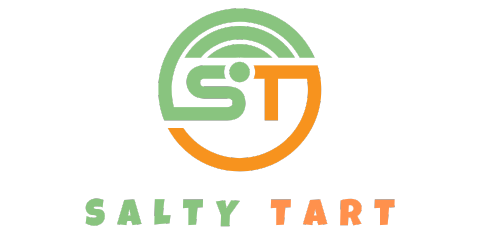
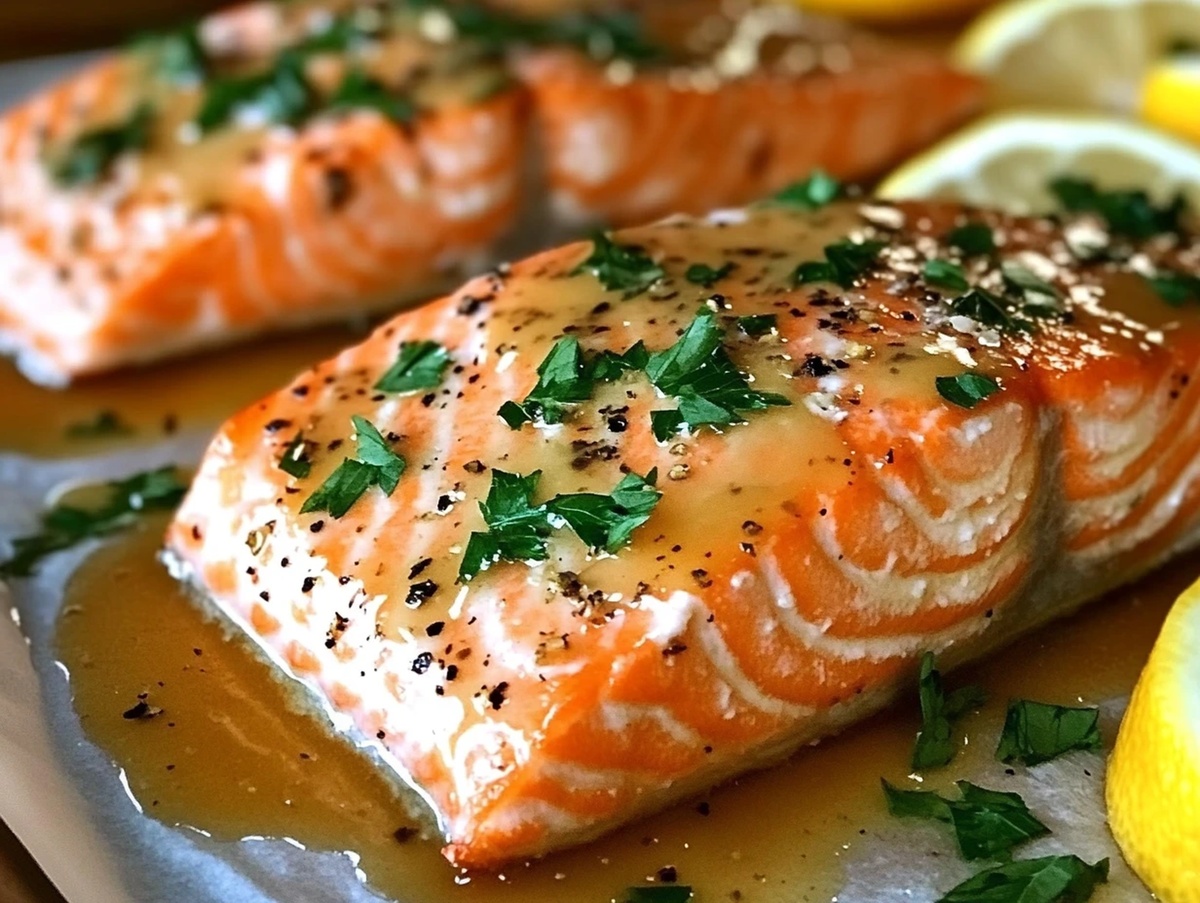
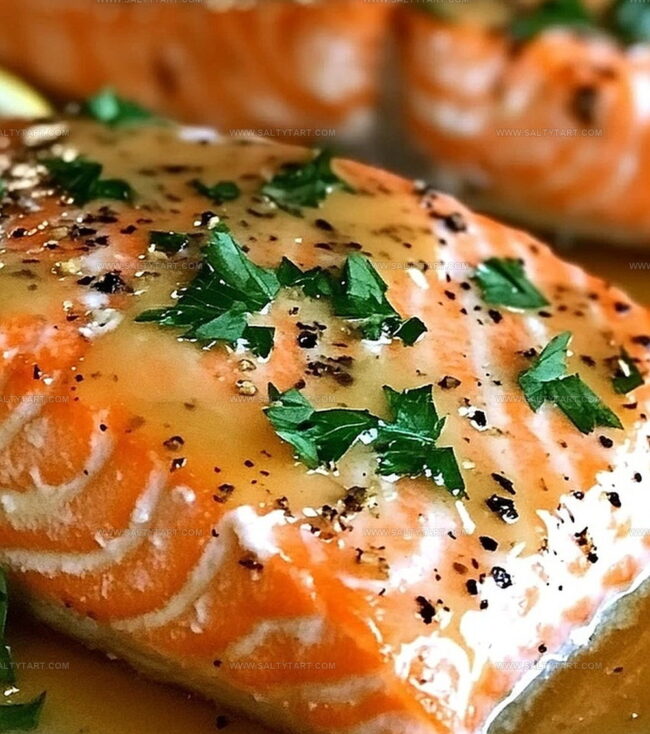
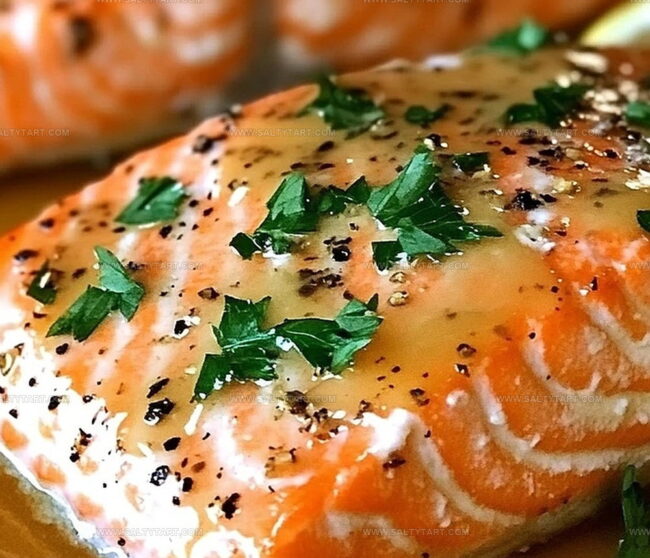
Mike Reynolds
Founder & Recipe Developer
Expertise
Farm-to-table cuisine, Seasonal recipe development, Sustainable cooking techniques, Food photography
Education
Asheville-Buncombe Technical Community College (A-B Tech)
Associate Degree in Culinary Arts
Mike studied culinary arts with a strong focus on farm-to-table principles and sustainable cooking. His training emphasized the importance of fresh, local ingredients and environmentally responsible practices in the kitchen.
Mike’s food journey began deep in the Blue Ridge Mountains, where weekends at farmers’ markets and home-cooked meals sparked a lifelong obsession with simple, seasonal eating.
After earning his Associate Degree in Culinary Arts from Asheville-Buncombe Technical Community College, he set out to bring farm-to-table cooking into everyday kitchens, without the fuss.
Mike’s philosophy is all about keeping it fresh, unfussy, and full of heart. When he’s not crafting new single-serving recipes, he’s hiking mountain trails, chatting with local farmers, or experimenting with wild ingredients in his backyard kitchen.